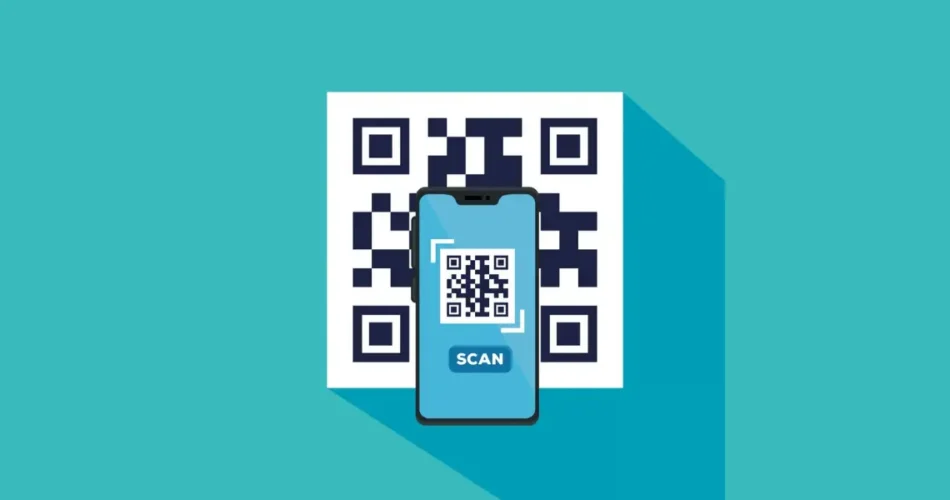While traditional QR Codes have served their purpose well, there’s a new player in town – vector QRs.
Offering unparalleled scalability, customization, and visual appeal, vector QRs are revolutionizing the way we perceive and utilize these ubiquitous symbols.
So, if you’re ready to take your QR game to the next level and unlock a world of limitless possibilities, stay tuned as we embark on an exciting journey into the realm of vector QR Code generator.
A. Why vector QR Codes matter in modern marketing

In today’s fast-paced digital landscape, effective marketing hinges on innovation, creativity, and staying ahead of the curve.
As consumers’ attention spans grow shorter and competition intensifies, the need to capture and retain audience engagement has never been more critical.
Enter vector QRs – the game-changer that’s revolutionizing modern marketing strategies.
Here’s why vector QRs matter in modern marketing:
1. Visual appeal
In a sea of mundane marketing materials, vector QRs stand out as visually striking elements that instantly grab attention. With their sleek, customizable designs and crisp resolution, vector QRs add a touch of sophistication to any campaign, enhancing brand recognition and leaving a lasting impression on consumers.
2. Scalability
Unlike traditional QRs that suffer from pixelation and loss of quality when resized, vector QRs maintain their clarity and sharpness no matter how large or small they’re displayed.
This scalability ensures that your marketing materials – whether they’re printed on billboards, flyers, or business cards – always look professional and scanable, regardless of size.
3. Customization
Vector QRs offer unparalleled customization options, allowing marketers to tailor their codes to align with their brand identity, color scheme, and messaging.
Whether it’s incorporating company logos, adding branded colors, or embedding images within the code itself, vector QRs provide endless opportunities for creative expression and brand storytelling.
4. Trackability
In the age of data-driven marketing, tracking and analyzing campaign performance is crucial for optimizing ROI and refining strategies.
Vector QRs enable marketers to track scans in real-time, providing valuable insights into consumer behavior, demographics, and engagement metrics. This data allows marketers to fine-tune their campaigns, target specific audiences, and measure the effectiveness of their QR Code initiatives.
5. Versatility
From digital advertisements and product packaging to event promotions and social media campaigns, vector QRs can be seamlessly integrated across a wide range of marketing channels and platforms.
Their versatility makes them a versatile tool for driving customer engagement, facilitating transactions, and enhancing the overall brand experience.
6. Interactive experiences
Vector QRs have the power to transform passive marketing materials into interactive experiences that captivate and engage audiences.
Whether it’s unlocking exclusive content, accessing special offers, or participating in interactive games and contests, vector QRs create memorable touchpoints that foster deeper connections with consumers.
Generate a QR Code For Your Unique Case
START TODAY!
B. Advantages of vector QR Code technology

Vector QR Code technology offers a multitude of advantages that significantly enhance their usability and effectiveness in various applications.
Let’s delve into some of these key advantages:
1. Infinite scalability
Unlike traditional QRs which are made up of fixed-size pixels, vector QRs are composed of scalable vector graphics (SVG) that can be resized infinitely without loss of quality. This means they can be printed on any surface or displayed on any digital platform, from business cards to billboards, without compromising readability or scanability.
2. High resolution and clarity
Vector QRs maintain their sharpness and clarity even when scaled to very small or very large sizes. This ensures that they remain easily scannable by smartphones and QR readers, regardless of the viewing distance or resolution of the display.
3. Customization options
Vector QRs offer extensive customization options, allowing users to modify the design, colors, and even incorporate logos or images within the code itself. This flexibility enables brands to seamlessly integrate QRs into their visual identity and marketing materials, enhancing brand recognition and consumer engagement.
4. Error correction
Vector QRs support built-in error correction, which means they can still be scanned and decoded accurately even if the code is partially obscured or damaged. This ensures reliability and robustness in various scanning environments, minimizing the risk of failed scans and improving user experience.
5. Dynamic content
Vector QRs can store various types of data, including URLs, text, contact information, Wi-Fi credentials, and more. This versatility enables them to be used for a wide range of applications, from directing users to websites or social media profiles to providing additional product information or enabling digital payments.
6. Cross-platform compatibility
Vector QRs are compatible with all devices and platforms that support QR scanning, including smartphones, tablets, and QR Code readers. This ensures universal accessibility and usability, allowing users to interact with QRs seamlessly regardless of their device or operating system.
7. Real-time tracking and analytics
Vector QRs can be equipped with tracking and analytics features that allow users to monitor scan activity in real time.
This provides valuable insights into consumer behavior, demographics, and engagement metrics, enabling brands to measure the effectiveness of their QR campaigns and optimize their marketing strategies accordingly.
C. How vector QR Codes enhance branding and design

Vector QRs offer unique opportunities to enhance branding and design in marketing materials. Let’s explore how they achieve this:
1. Customization
Vector QRs provide extensive customization options, allowing brands to incorporate their logo, brand colors, and visual elements seamlessly into the design. This ensures consistency with the brand’s overall identity and helps to reinforce brand recognition among consumers.
2. Visual appeal
Unlike traditional QRs that may appear bland or out of place in design-oriented materials, vector QRs can be designed to complement the aesthetic of the marketing collateral. By integrating them organically into the layout and choosing appropriate colors and styles, brands can create visually appealing QRs that enhance the overall design and attract attention.
3. Brand storytelling
Vector QRs offer opportunities for creative storytelling within the design itself. Brands can use them to convey additional information, messages, or calls to action that aligns with their brand narrative.
Whether it’s highlighting product features, sharing customer testimonials, or promoting social causes, vector QRs can serve as interactive touchpoints that deepen engagement and foster emotional connections with consumers.
4. Versatility in placement
Vector QRs can be placed strategically within marketing materials, such as posters, brochures, packaging, or digital assets, to maximize their impact.
Their scalable nature allows them to fit seamlessly into various design layouts without detracting from the overall aesthetics. This versatility enables brands to experiment with different placement options and optimize the visibility and effectiveness of their QR campaigns.
5. Integration with multimedia content
Vector QRs can be linked to multimedia content such as videos, animations, or interactive experiences, enriching the consumer’s brand experience.
By scanning the QR, users can access additional content that complements the marketing message and provides value-added information or entertainment. This integration of multimedia content enhances engagement and creates memorable brand interactions that leave a lasting impression on consumers.
6. Data capture and analysis
Vector QRs can be equipped with tracking and analytics capabilities, allowing brands to capture valuable data on consumer behavior and engagement metrics. This data can inform future marketing strategies and help brands refine their messaging, design, and targeting efforts for optimal results.
D. Vector QR Codes: Optimizing for print and digital media

Optimizing vector QRs for both print and digital media involves several considerations to ensure they maintain clarity, scanability, and visual appeal across different formats.
Here’s how you can optimize vector QRs for both mediums:
1. Resolution and scalability
Vector QRs inherently offer scalability without loss of quality. However, it’s essential to determine the appropriate size and resolution for both print and digital applications. For print media, ensure that the QR is large enough to be easily scanned without compromising design aesthetics. In digital media, consider factors such as screen size and viewing distance to determine the optimal size for the QR.
2. Color and contrast
Choose colors and contrast levels that ensure optimal scanability and readability, especially against different background colors or patterns. High contrast between the QR and its background is crucial for accurate scanning. For print media, ensure that the QR contrasts well with the background color or texture of the material it’s printed on. In digital media, test the QR against various background colors and adjust as needed.
3. Quiet zone and margins
Maintain an adequate quiet zone or margin around the QR to prevent interference and ensure accurate scanning. For print media, ensure that there’s enough space around the QR to prevent crowding or overlapping with other elements. In digital media, adjust the positioning of the QR to provide sufficient margins and avoid overlapping with other on-screen elements.
4. File format
When exporting vector QRs for print media, use file formats that are compatible with professional printing processes, such as PDF or EPS. These formats preserve the vector graphics and ensure optimal print quality. For digital media, SVG format is ideal for vector QRs as it maintains scalability and compatibility across different devices and platforms.
5. Error correction level
Choose an appropriate error correction level based on the intended use and scanning environment. Higher error correction levels provide greater resilience to damage but result in larger QR sizes. For print media, consider using higher error correction levels to ensure scanability even if the QR is printed at a smaller size or on low-quality materials. In digital media, balance error correction with file size considerations to optimize performance.
6. Testing and optimization
Before finalizing vector QRs for print or digital distribution, thoroughly test them across different devices, screen resolutions, and printing methods. Ensure that the QRs are easily scannable and maintain visual clarity in various scenarios. Make any necessary adjustments or optimizations based on testing results to ensure optimal performance across all mediums.
E. Integrating vector QR Codes into your marketing strategy

Integrating vector QRs into your marketing strategy can significantly enhance engagement, drive conversions, and provide valuable insights into consumer behavior.
Here’s how you can effectively incorporate vector QRs into your marketing efforts:
1. Enhance print collateral
Add vector QRs to your print materials such as brochures, flyers, posters, and business cards to provide additional information, promotions, or interactive experiences. For example, a QR on a product brochure could lead customers to a product demo video or a special offer on your website.
2. Boost digital campaigns
Integrate vector QRs into your digital marketing channels such as email newsletters, social media posts, and digital ads to drive traffic to specific landing pages, promotions, or downloadable content. Include a clear call-to-action encouraging users to scan the QR for exclusive access or discounts.
3. Improve product packaging
Incorporate vector QRs into your product packaging to provide product information, user manuals, or links to instructional videos. This adds value to the customer experience and can help build brand loyalty by providing convenient access to relevant resources.
4. Enable mobile payments
Utilize vector QRs to facilitate mobile payments and streamline the checkout process for customers. Whether it’s in-store payments or online transactions, QRs can provide a quick and secure way for customers to complete their purchases using their smartphones.
5. Drive event engagement
Use vector QRs at events such as conferences, trade shows, and workshops to facilitate attendee engagement and interaction. Create QRs for event registration, session schedules, feedback surveys, or access to exclusive content, enabling participants to easily access information and engage with your brand.
6. Track and analyze performance
Implement tracking parameters in your vector QRs to monitor scan activity and analyze campaign performance. Use analytics tools to track metrics such as scan frequency, location, and time of day to gain insights into consumer behavior and optimize your marketing strategy accordingly.
7. Create interactive experiences
Leverage vector QRs to create interactive experiences that captivate and engage your audience. Whether it’s scavenger hunts, augmented reality experiences, or gamified promotions, QRs can serve as entry points to immersive brand experiences that leave a lasting impression on consumers.
8. Offer exclusive content
Use vector QRs to provide access to exclusive content, behind-the-scenes footage, or sneak peeks of upcoming products or events. This creates a sense of exclusivity and incentivizes users to scan the QR to unlock valuable content that’s not available elsewhere.
F. Best practices for implementing QR Codes

Implementing vector QRs effectively requires attention to detail and adherence to best practices to ensure optimal performance and user experience.
Here are some key best practices for implementing vector QR codes:
1. Choose a reliable QR Code generator
Select a reputable QR Code generator tool or service that supports vector QR generation and offers customization options to suit your needs. Ensure that the generator produces high-quality vector QRs that are compatible with various devices and scanning environments.
2. Optimize for scanability
Ensure that the vector QR is easily scannable by using high contrast between the code and its background. Test the QR on different devices and under various lighting conditions to verify scanability, and make adjustments as needed to improve performance.
3. Customize design appropriately
Customize the design of the vector QR to align with your brand identity while maintaining scanability. Incorporate brand colors, logos, and visual elements tastefully, and avoid overly complex designs that may hinder scanability or compromise the integrity of the code.
4. Provide clear call-to-action
Accompany the vector QR with a clear and compelling call-to-action that instructs users on how to scan the code and what to expect upon scanning. Use concise language and visually distinct cues to encourage engagement and convey the value proposition of scanning the QR.
5. Ensure proper placement
Place the vector QR Code in prominent locations where it’s easily visible and accessible to your target audience. Avoid placing the QR in areas where it may be obstructed or difficult to scan, and provide adequate spacing around the code to prevent interference from surrounding elements.
6. Test across multiple devices
Test the vector QR across a range of devices, operating systems, and QR scanning apps to ensure compatibility and consistent performance. Verify that the QR scans accurately and redirects users to the intended destination without errors or disruptions.
7. Monitor performance and analytics
Implement tracking parameters in the QR Code URL to monitor scan activity and gather insights into user engagement. Use analytics tools to track metrics such as scan frequency, location, and time of day, and use this data to optimize your QR campaigns and measure their effectiveness.
8. Regularly update and refresh content
Keep the content linked to the vector QR up-to-date and relevant to ensure a positive user experience. Regularly refresh the content to provide users with new information, promotions, or offers, and avoid linking to expired or outdated content that may disappoint or frustrate users.
G. FAQs: Vector QR Code generator

Here are some frequently asked questions (FAQs) about vector QRs:
1. What is a vector QR Code?
A vector QR is a type of QR composed of scalable vector graphics (SVG) rather than fixed-size pixels. This allows the QR to be resized without losing quality.
2. How are vector QR Codes different from traditional QRs?
Traditional QRs are made up of fixed-size pixels and may lose quality when resized. In contrast, vector QRs are composed of geometric shapes that can be scaled indefinitely without loss of quality.
3. What are the advantages of using vector QRs?
The advantages of vector QRs include infinite scalability, high resolution and clarity, customization options, error correction, and compatibility with various devices and platforms.
4. How can I generate a vector QR Code?
You can generate a vector QR Code using Scanova’s QR Code Generator.
5. Where can I use vector QR Codes?
Vector QRs can be used in a wide range of applications, including print materials such as brochures, business cards, and posters, as well as digital media such as websites, social media, and mobile apps.
6. Are vector QRs compatible with all devices?
Yes, vector QRs are compatible with all devices that support QR scanning. This includes smartphones, tablets, QR readers, and other devices with camera functionality.
7. Can I customize the design of a vector QR Code?
Yes, vector QRs offer extensive customization options, including the ability to change colors, add logos, and incorporate visual elements to align with your brand identity.
8. How do I ensure that my vector QR is scannable?
To ensure that your vector QR is scannable, maintain high contrast between the code and its background, provide sufficient quiet zone or margin around the code, and test the code on various devices and scanning environments.
9. Are there any limitations to using vector QR Codes?
While vector QRs offer many advantages, they may have larger file sizes compared to traditional QRs, especially for complex designs. Additionally, not all QR generators support vector output, so it’s important to choose a reliable tool.
10. What are some best practices for using vector QRs?
Best practices for using vector QRs include optimizing for scanability, providing clear call-to-action, ensuring proper placement, monitoring performance and analytics, and regularly updating content to provide value to users.
Summing Up
From their unparalleled scalability and customization options to their seamless integration into both print and digital media, vector QRs have become indispensable assets in modern marketing strategies.
If you’re still reading, you’ve learned everything about vector QR Code generator. If you have any questions, let us know in the comments.
Always go for a reputed QR Code service provider to generate QR Codes!
Generate a QR Code For Your Unique Case
START TODAY!

Hi, I have read your blog, it’s very amazing, it has helped me to get a knowledge about blogs & I will implement this on my website as well. Please continue to provide knowledge with your blogs.
Thanks for your kind words, Sirwani.